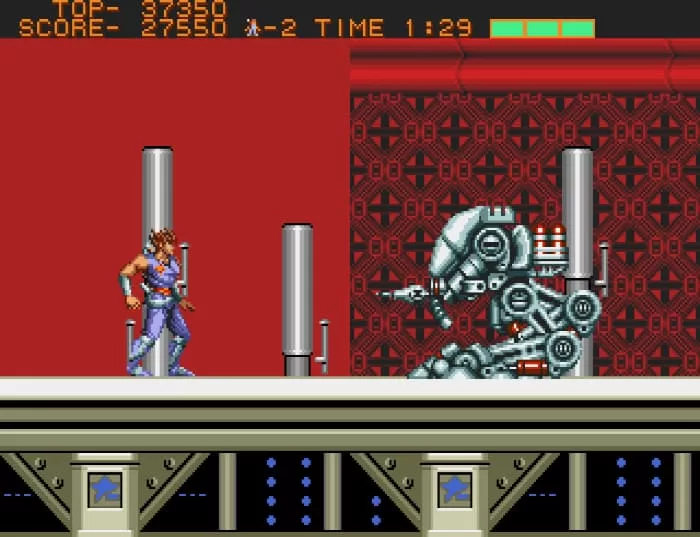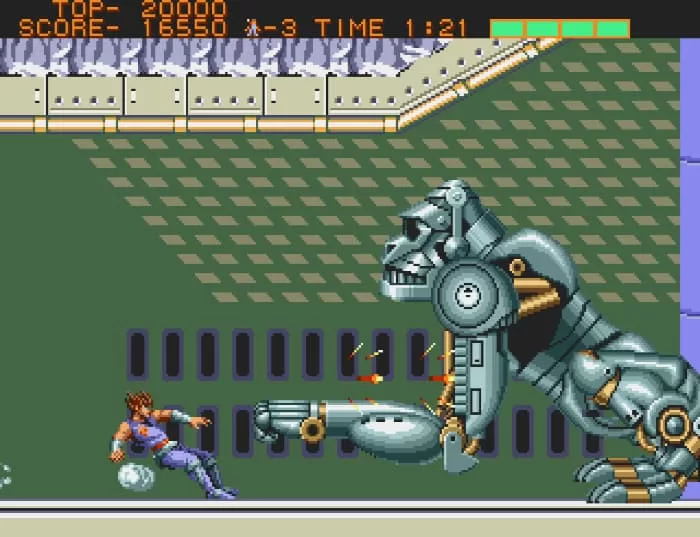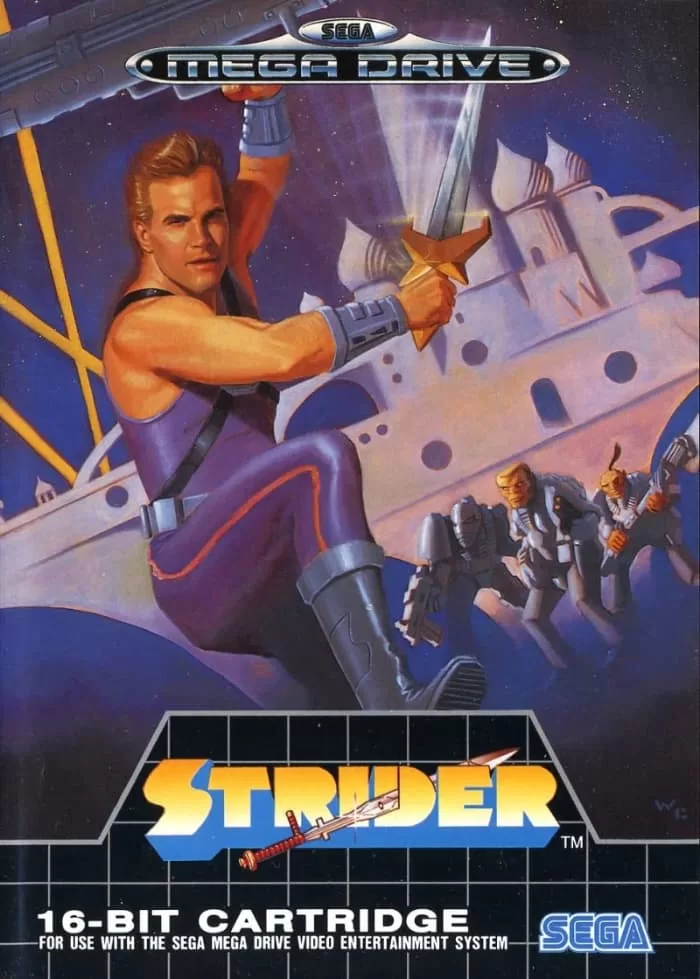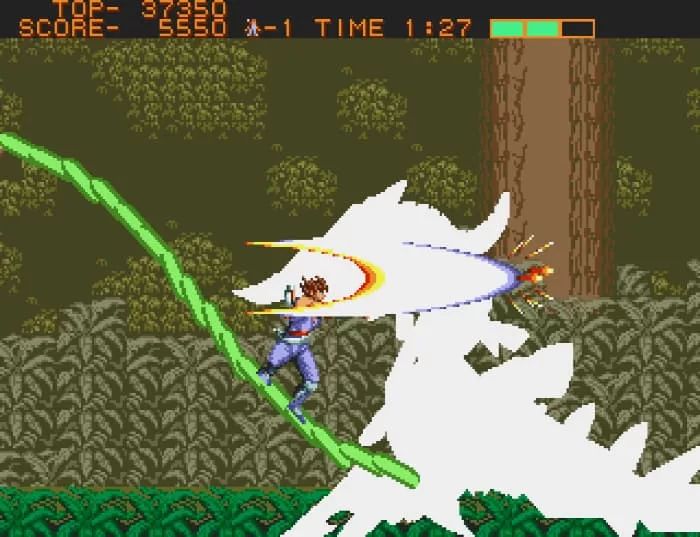
Capcom’s Strider for the Mega Drive is a stone-cold retro classic, and one that every gamer should experience. It’s also a good example of how marketing and design can make a great game look awful.
In Retro Game Of The Week I pull a game from my collection and write about why it’s important or interesting. Or in some cases, badly dated and rubbish.
Do I really need to introduce Strider, Capcom’s 1989 classic run, jump and slash-them-up game? It really does feel to me like one of the well-known and widely loved classics, but maybe you’re new to it.
[Movie announcer voice on]
It is the year 2048.
Humanity is enslaved under the cruel tyranny of grandmaster Melo.
Only one man can make a difference.
That man is Strider Hiryu.
[Movie announcer voice off]
That’s about all you really need to know about Strider before you start playing it. One fun bit of trivia here (that I personally didn’t know until I was researching this, your mileage may vary) was that Strider was sort-of a Manga before it was an arcade game, and then ported to many systems — of which the Mega Drive version of Strider is easily the best.
I say sort of, because unlike the many Manga-derived games that have existed forever, the original Manga was a co-creation with Capcom from the get-go. To get into marketing/linguistics theory for a second, it’s a classic example of a media mix approach.
Ahem. Less of the academics, Kidman, more of the slashy-slashy boom-boom.

Strider knows how to make politics more engaging.
I mean, you’d pay more attention to your MP if they turned into a gigantic robo-centipede, wouldn’t you?
The thing here is that the plot can be treated rather like set dressing, and you don’t particularly have to pay that much attention to it. While Strider does has simple cut scenes and one of the most glorious evil villain laughs in all of gaming, the basic resolution of each level is much the same.
Run and jump to the left and right, using your plasma sword and a variety of robot friends to overcome the increasingly bizarre army of bad guys out to stop you.

“With the help of his Robot Friends!!!!!”
There’s a little bit of everything here, from a Politburo that becomes a mechanised centipede to killer Amazonian warriors armed with boomerangs, airships and more. For a game with only five levels, it crams a lot in.

That’s no moon…
There’s a modern idea that a game that is short — and Strider is not long — isn’t a good game, because content is everything. I don’t subscribe to that idea for most cases; there are games that can feel “short” in that they under-utilise their gaming concepts, but Strider’s not one of those.

You now have 20 seconds to comply…
That’s largely because just about every aspect of the game is beautifully realised, even given the Mega Drive’s hardware limitations. At the time, it was revelatory to have a game skew quite this close to the arcade original, because while it might not have quite as many animation frames, it well and truly has enough to be eye catching.

Strider Hiryu starts to think that he may have taken that last jump wrong.
The same is true for the score, and indeed the iconic “CHING” sound that your plasma sword makes every time you swing it. In the average game of Strider, you’ll hear it a lot. It’s one of those iconic retro gaming sounds, along with sounds like the OG Doom shotgun that has serious impact. It just sounds solid, and its effect on enemies is equally satisfying.

Like me, Strider Hiryu greatly prefers Godzilla over Kong.
Or in this case, Mecha-Kong.
It’s also one of very few instances where I think the Mega Drive was probably the ideal platform for the game, sonically speaking. As you probably know, my heart belongs to the SNES, but I just can’t imagine its sound platform giving Strider’s plasma sword the right sibilance in the way that the Mega Drive’s digital synth gets perfectly.

Would this sound as good coming out of a SNES? Discuss.
You want to know what’s less satisfying in Strider?
The way it was sold outside of Japan. My own copy is a Japanese one — a later purchase, I’ll get into that momentarily — and if you had a full boxed version, it looked like this:

Sure, it could be sharper, but it does a great job of conveying the game type, tone and setting.
(Image grabbed from the Internet, (c) Capcom, I guess)
So it’s the early 1990s by the time the Mega Drive makes its way to our shores, and you’ve got this superb cover to use. What do you do? You do… this:

That’s… bad. I mean, not Phalanx-bad… but maybe it is, actually. At least Phalanx is weird.
(Image grabbed from the Internet, (c) Capcom, I guess. They might not want to admit that.)
I don’t even know where to start with that, because the only thing I like on it is the Mega Drive logo that was on everything. No Americans, it’s not the “Genesis”, and that IS a hill I’m willing to die on.
But aside from that, you’ve got Wish-brand Michael Dudikoff swinging an actual freaking SWORD while wearing an expression that looks like he’s either forgotten his next line, or he’s just soiled himself, in front of some cheap Space Marine knock-offs crayoned in by an eight-year old, themselves in front of something vaguely Soviet, probably traced off the back of the Tetris box.

The feeling of doing this is sublime. The Western box art is… subpar.
It’s awful, and it so, so fails to grab the essential essence and joy of playing Strider. Strider’s an inherently kinetic experience that sucks me into its gameplay loop every single time I pop the cartridge in. There’s also a very obvious line of game design thinking between the way it handles its 2D plane combat and future fast weapon swinging games of the Devil May Cry, God of War or even the Souls genre of games, too, if you like your game analysis to be more on the historical side.
Short form: Strider is a gem that is not to be missed. Its western box art is not.
How to play Strider (Mega Drive) today

That’s my copy of Strider above, and while it’s a game that I’ve loved ever since I first dropped a 20p coin into a machine in the East End of London — it was nestled between Double Dragon and Golden Axe in a nearby terrible gym, if I recall correctly — it’s another fairly recent purchase in my collection.
I just hated the box art that much, plus I didn’t come across it all that often at reasonable prices — right up until I saw a cart-only copy in a junk bin in Hiroshima. At 800 yen (~$8 AUD, give or take) I wasn’t going to pass it up.
You don’t have to travel to Hiroshima (though you should, the Okonomiyaki is to die for) to play the Mega Drive version, however.
The simplest and easiest way to play it is through the Nintendo Switch Online service, where it sits with other Mega Drive titles if you have the Expansion pack version of Switch online. Locally that’s (sigh) with the terrible Western box art, but it’s still good underneath that disaster area.
What if you like cartridges, like I do? The good news here is that while Strider is one of the Mega Drive greats, and that means it sold a lot of copies. Mega Drive game carts came in solid boxes (some of which had terrible box art), and many of them survive to this day.
As a result, it’s relatively affordable if you want a real physical copy.
You’re looking at (typically) something like $20-$30 for a loose cart, maybe $50-$100 for a boxed copy.
Just avoid Strider II — it’s SO awful — and you’ll be looking at a true retro gaming classic and bargain all in one.





